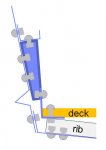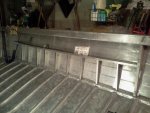Got to work on the old Holly this weekend and actually made some decent progress. We drilled out the last 4 rivets on each of the rib ends where there were hairline cracks or where we thought there could be an issue in the future (9 on one side and 8 on the other). Then we placed a scab on the outside of the hull and bucked solid rivets through the hull, ribs, and scabs. We may have gone a little overboard on how many we did, but now I have peace of mind that there will not be any more cracking on the rib ends.
We also got 8 braces installed on each side of the hull to isolate the spray rails. Besides the scabs and braces, we had about 20 miscellaneous rivets to replace from our prior leak tests. All in all, we set about 150 rivets. We did all of the drilling on Friday night and all of the riveting on Saturday.



Here were some of my biggest takeaways from the weekend of hull riveting:
-I didn?t find the punch to be much of a help when drilling out the brazier head rivets. We had better luck drilling a pilot hole with a small (3/32??) bit and then stepping up to a 3/16? bit.
-I did not buy a bucking bar. I was the guy inside the boat. Depending on whether I was bucking on a rib or in the open, I used an old railroad spike for tight spaces and a 4 lb. steel drilling hammer for the open areas. We got along just fine.
-Somehow, I think I got different alloys for the solid rivets I bought. The 7/16? rivets were softer and much easier to install than the 3/8?. Ultimately, both created a watertight seal, but the harder (shorter) rivets took SIGNIFICANTLY more effort to buck. Perhaps a tungsten bucking bar would have helped here, but I?ll never know.
-We set our compressor a little higher than most. 55 psi gave us the best results.
-You guys were not kidding about how messy that 5200 is! My hands are still a mess.
-The inside of a bare aluminum hull on a sunny day is a great place to catch a suntan/burn.
We did a leak test after setting the rivets (before we used the Coat It) and there were still some minor leaks (including the front keel strip going up the bow), but there was a huge improvement. We rebucked a few of the rivets and ran a thin bead of leftover 5200 on the outside of the front keel strip because all of the rivets looked rock solid but there was still a little water oozing out of that seam. That left us with 2 small drips: 1) a rivet that we know we did a poor job of replacing, and (2) the rear edge of the front keel strip that we couldn?t seal with 5200 because the trailer roller was in the way. We drained, cleaned, and dried the hull Saturday night before applying the Coat It. Unfortunately, a combination of carelessness, slight inebriation, and poor communication led to me not knowing there was only a 30 minute working time. I got halfway done with the boat before the can started getting extremely hot and then it was all downhill from there. It wasn?t long before we had a block of epoxy in a can. Oh well, you live and you learn.
The plan going forward is to ?Coat It? the rest of the boat for good measure and do a final leak test. I think we are going to be bone dry. The deck, transom, floor joint supports, and seats are ready to be installed. Still need to pick up some closed cell foam. This week didn?t result in a lot of visual progress, but we should progress quickly now that the hull reinforcement and leak testing is largely behind us.
Finally, I used that vinyl spray paint to paint the ugly yellow panels underneath the bow and I am very happy with how it turned out. Sorry for the poor picture.





































